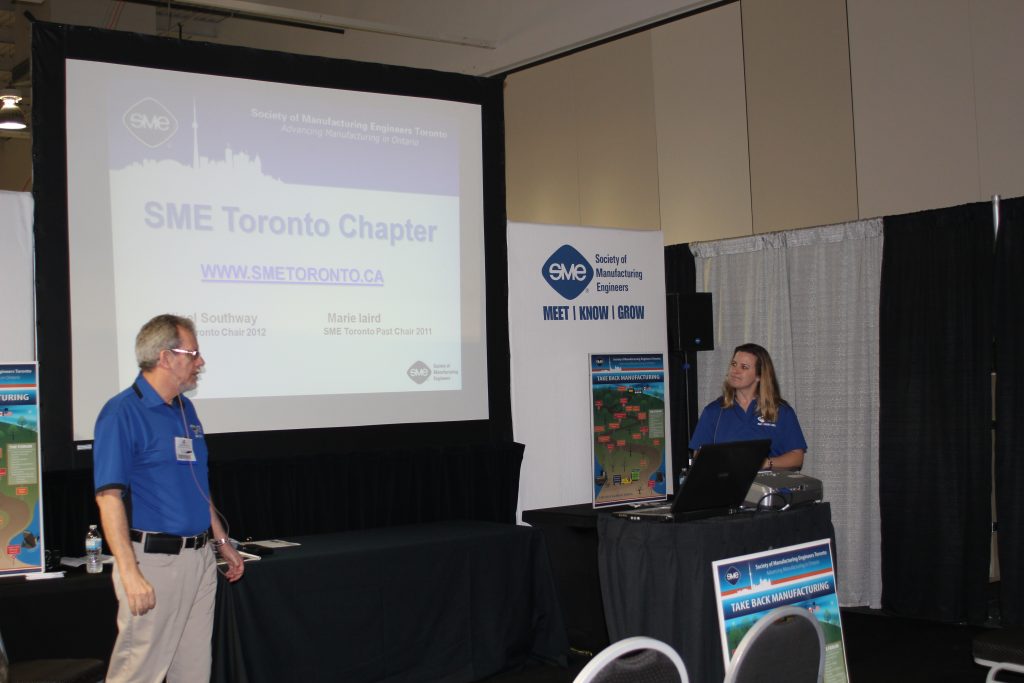
SME continues its push to ‘Take back manufacturing’ in Canada
March 27, 2012
By
Mary Del
 Nigel Southway
Nigel Southway The Society of Manufacturing Engineers’ Toronto chapter was at Fabtech Canada this month educating attendees about its “Take back manufacturing” (TBM) campaign, which is aimed at getting government, educators and industry leadership to work closer together to plan the recovery of the declining manufacturing sectors in Ontario.
The TBM forum is a group of like-minded organizations, including technical associations, trade associations, educational policy makers, media experts, local government reps and industry experts. The premise is to speak with one voice and work towards one goal on one agenda.
The group presented the campaign at the Canadian Manufacturing Technology Show in Toronto last October, and is happy with the attention it has received so far.
“We’ve had a tremendously powerful positive response from just about everyone in the industry,” said Nigel Southway, SME operations lead, who co-presented a 45-minute demonstration outlining the initiative and its goals at the SME booth throughout the three days of Fabtech Canada with colleague Marie Laird, chair of the Toronto chapter of the SME. “Manufacturers get it.”
But the SME is hoping for more involvement. That’s why the Toronto chapter is asking manufacturers and anyone interested in keeping the industry alive in Canada to take its TBM self-positioning survey — 40 questions aimed at helping the SME gain a better understanding of the needs of the industry. Southway said that questions are aimed at determining what the market thinks it needs in terms of capability, and where they think they are in terms of their position in the competitive world. Answers are kept confidential. To take the survey, visit http://www.sme-tbm.org/tbm-roadmap-1/.
During the SME presentation at Fabtech, Southway and Laird outlined the TBM roadmap, which, if followed, they believe will improve Canada’s manufacturing competitiveness, reverse the weak manufacturing position and improve prosperity.
The roadmap addresses what they consider to be major issues, including low unemployment, an untrained workforce, dated management practices, lower productivity and expensive products. The biggest of these issues, said Southway, is the untrained workforce.
“We actually see [the] untrained workforce [as] being a future threat to the new world that we see because, unfortunately, the next generation of engineers, technologists and skilled people we need won’t be there unless we plant it in place.”
To address this, the forum recommends a joint apprenticeship training board, a career development plan for students, and a training program that’s integrated with industry. This training and having close ties with industry will help pass along the knowledge of those set to retire in the next decade, and also help to keep students abreast of the latest technology, which frequently evolves.
And for those already in manufacturing with dated management practices, the forum recommends professional retraining programs.
The group is currently in Phase 2 of the campaign — getting government to listen.
“We do have some reasonable attention span now in the Ontario government,” said Southway.
He said some of this is thanks to TBM forum member the Professional Engineers of Ontario (PEO).
“The Professional Engineers of Ontario have a lot more lobbying capability than SME. They are quite strongly connected with policy makers,” he said. “We do need help from government in terms of policy reviews…We see the PEO helping us with that.”
Phase 1 was the TBM awareness stage, while Phase 3 will focus on education.
“What we really think is important is emotionally getting behind the idea that manufacturing is important and saying, ‘Yes, we can do something about this.’ The biggest issue we face is apathy — people that give up too easily. We really believe that it’s important that people believe that there’s a roadmap to get there,” said Southway. “The numbers show that we can get there. The numbers show that, theoretically, if we do balanced sourcing, and certainly with the U.S. dollar, it’s time to reshore. I think the other thing that’s big is that the U.S. is definitely getting its head around the idea that this is the right thing to do. I think the politics in the U.S. will help our case.”
He continued: “We’re finding that everyone we talk to, the general public, they get it. They don’t like seeing ‘Made in China’ on the bottom of stuff. A lot of people believe that they’d rather pay more for products and have jobs,” he said. “If we could find a way to increase the cost of some of our disposable products, the luxury products — not our food, not our health care, not our schooling, just the stuff that we spend extra money on — if we made those more expensive, then everybody would have a job and their kids would have a job. It’s that kind of economic balance that we need to try to meet.”
“There are two million people in manufacturing,” said Laird. “If we speak together, if we work together, we can make this happen.”
For more information on TBM, or to find out how you can get involved, visit http://sme-tbm.org/.